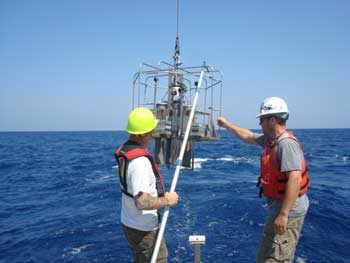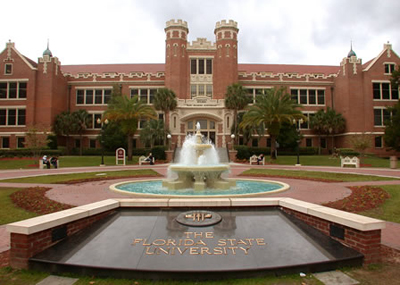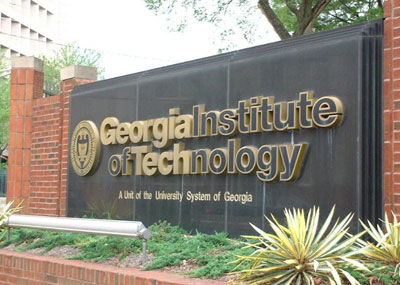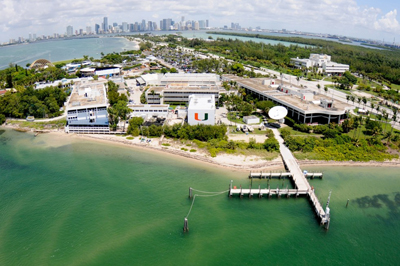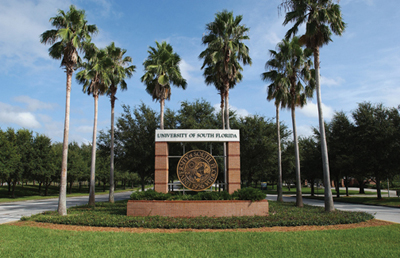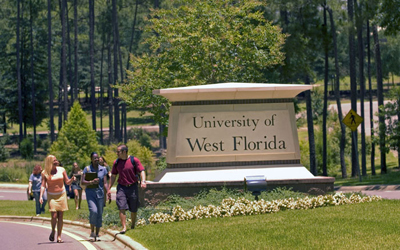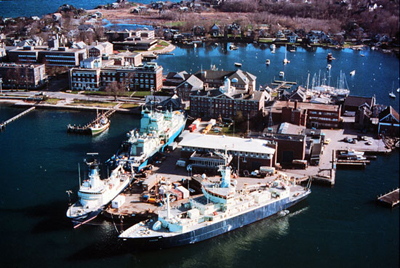Third Anniversary of Oil Spill
An Update on Scientific Research in the Gulf of Mexico
![]() How to Contact the Experts
How to Contact the Experts
|
|
April 12, 2013 -- Nearly three years ago, in the wake of an explosion on the Deepwater Horizon drilling rig, thousands of barrels of crude oil were flowing into the ocean daily from a damaged well about 40 miles southeast of the Louisiana coast. Eleven individuals lost their lives on April 20, 2010 and the flow of oil continued for nearly three months while scientists and engineers worked to cap the Macondo well. The disaster would eventually become the largest accidental marine oil spill in history.
“When the oil spill occurred in 2010, we needed to be able to predict what would happen to the oil as it was released and moving through the Gulf of Mexico, from the deep sea to the coast. But our understanding of the biological and chemical processes was limited,” notes Dr. Eric Chassignet, director of the Deep-C Consortium and the Florida State University Center for Ocean-Atmospheric Prediction Studies (COAPS). “One of the outcomes of the 2010 spill is research concentrated in the Gulf of Mexico that is enabling us to better understand the environmental complexity of the Gulf and therefore more accurately predict the impact of an event like an oil spill.”
The Deep-C (Deep Sea to Coast Connectivity in the Eastern Gulf of Mexico) Consortium was one of eight research consortia funded in 2011 by Gulf of Mexico Research Initiative to investigate the fate of petroleum in the environment, the impacts of the spill, and the development of new tools and technology for responding to future spills and improving mitigation and restoration. Deep-C member institutions include the Dauphin Island Sea Lab, Florida State University, Georgia Institute of Technology, Naval Research Laboratory at Stennis Space Center, Norwegian Meteorological Institute, SAIC, University of Miami Rosenstiel School of Marine and Atmospheric Science, University of South Florida, University of West Florida, and Woods Hole Oceanographic Institution.
What Have We Learned?
On the third anniversary of the oil spill, Deep-C scientists studying the long-term effects of the 2010 spill say:
- We cannot rely on oil-eating microbes alone to clean up oil spills. Some bacteria and fungi (called microbes) regularly biodegrade or “eat” compounds found in the oil that is naturally present on the Gulf floor. Within months after the Deepwater Horizon spill, these microbes are thought to have eaten a large portion of the oil. However, the population of these microbes is proportional to the supply of oil. When an oil spill occurs, there are not normally enough microbes present to degrade the oil before it causes ecological damage. While the population of microbes may eventually increase in response to a spill, other methods, such as immediate containment or physical removal of oil, are important defenses.
- A large amount of oil mixed with sediments and plankton and was dragged down to the bottom of the Gulf in a “dirty bathtub/dirty blizzard” effect. Some portion of oil from the spill combined with sediments and plankton, creating a “dirty bathtub” layer more than 1,000 meters beneath the surface. The oil caused particulates to clump together and caused a “dirty blizzard” that sent contaminated sediments to the sea floor at 10 times the normal rate. This helps explain why some water closer to the surface was unusually clear during the spill. DNA analysis showed the presence of diatoms in the sediment consistent with its rapid delivery to the seafloor.
- Some carbon released from the oil spill entered the food web through bacterial consumption of methane. Approximately a third of the carbon released during the Deepwater Horizon oil spill was methane (better known as natural gas). Certain bacteria (methanotrophic) which are exceptionally good at absorbing or consuming methane are, in turn, eaten by plankton and other aquatic organisms. Using stable isotopes and radiocarbon tracers, scientists have been able to confirm this occurred during the 2010 oil spill. However, methane is non-toxic and does not represent a safety risk.
-
While we continue to find new deep sea species previously unknown to science, the impact of oil and dispersants on life history patterns is just starting to unfold. Despite the fact that fish nearer the Macondo well blowout site experienced greater exposure to oil and metabolized it at a higher rate than those collected further away, the level of oil residuals in their tissues is relatively low. This begs the question, ‘How does oil exposure affect growth, reproduction, and general health of deep sea animals?’ Knowing the answer to this question improves our understanding of the long-term effects of these pollutants on fish and other animals.
Deep-C scientists with a six-gill shark, Hexanchus griseus. Photo credit: Dean Grubbs, FSU.
High resolution image. - Oil that came ashore triggered a bloom of bacteria that quickly consumed much of the oil compounds on Florida beaches. A large increase in the numbers of bacteria was observed in parallel with the consumption of oxygen and the majority of highly degradable oil hydrocarbons during the first four months after oil came ashore. For the first time, the application of cutting-edge gene sequencing techniques revealed a dramatic impact of oil on microbial diversity and the types of microbes present in beach sands after oiling. A time series of genetic data revealed succession as the types of microbes present changed in parallel with changes to the oil compounds present. A little over a year after the spill, microbial communities returned to close to their original condition.
- Current oil detection methods are insufficient. To determine the extent of oil spills, scientists collect samples from spill sites and use laboratory equipment to analyze the chemical components of the samples. However, recent research has shown that the standard lab tests that are typically practiced fail to detect some chemicals, which can hinder our understanding of the size of a spill, our accounting for “missing” oil, and our ability to protect marine organisms that may be sensitive to specific chemicals.
- More accurate prediction of the fate of future ocean events such as an oil spill is dependent upon development of a sophisticated model that includes exchange processes between sediment, water, and atmosphere; biogeochemical processes, the transport of organisms, and the effects of petroleum hydrocarbons on all of these processes. The data currently being collected by Deep-C scientists in the field will allow simulations of oil spill scenarios, producing projections of changes in ecosystem services that can support decision making and forecasting of potential socioeconomic outcomes. The combination of earth system and food web models will produce a powerful tool set that can be used to investigate and forecast environmental impact scenarios, and to assess the influence of hydrocarbon releases on fisheries, tourism, and human health.
The Deep-C consortium is a long-term, interdisciplinary study investigating the environmental consequences of petroleum hydrocarbon release in the deep Gulf of Mexico on living marine resources and ecosystem health. The consortium focuses on the geomorphologic, hydrologic, and biogeochemical settings that influence the distribution and fate of the oil and dispersants released during the Deepwater Horizon accident, and is using the resulting data for model studies that support improved responses to possible future incidents. Deep-C research was made possible by a grant from BP/The Gulf of Mexico Research Initiative. For more information visit www.deep-c.org or contact Tracy Ippolito, Deep-C Coordinator at 850-645-0060.
Contact the Experts
Following is a list of Deep-C researchers available to address questions related to the oil spill or Gulf of Mexico research. They are grouped by affiliation and by area of expertise.
|
Ecology and the Environment: Jeff Chanton, professor of chemical oceanography - Chanton’s research focuses on light hydrocarbon gases, particularly methane, in the ocean and seafloor. He has extensive experience in marine geochemistry, particularly with regard to seafloor sediments. Dr. Chanton is available to discuss the effect of hydrocarbons on the food web, chemosynthesis, and sedimentation. Felicia Coleman, scientific director of the Deep-C Consortium and director of the FSU Coastal and Marine Laboratory – Coleman has expertise in the areas of marine ecology and fisheries science and policy. Dr. Coleman is available to discuss the ecological consequences of the oil spill to coastal habitats and organisms in general and to fisheries and fishing communities specifically. Dean Grubbs, research faculty at the FSU Coastal and Marine Laboratory - Grubbs has been studying the ecology of deepwater fishes ranging from cutthroat eels to large sharks. He and his colleagues are investigating the structure of deepsea fish communities of the continental slope and DeSoto Canyon and possible effects of oil on these fishes. Dr. Grubbs is available to discuss diversity and ecology of deep sea bony fishes and sharks in the Gulf and how oil-related toxins, such as polycyclic aromatic hydrocarbons (or PAHs), may be affecting animals. Markus Huettel, professor of oceanography - Huettel is a benthic ecologist researching how much and what oil components were transported into Gulf beach sands during the spill, how deep these oil components penetrate, and how rapidly they are degraded. Dr. Huettel is available to discuss microbial groups that degrade the oil and how the oil changes the microbial community in the sand and sediment biogeochemistry. Ian MacDonald, professor of oceanography - MacDonald is an oceanographer of deep-ocean extreme communities who uses imaging and GIS techniques to investigate the ecology of deep-sea hydrocarbon seeps. At the time of the BP well blowout, Macdonald asserted that reports on the volume of oil being discharged were greatly underestimated. Dr. MacDonald is available to discuss the presence oil from natural seeps, as well as oil in sediment and water samples. Telephone: (850) 644-5498 Alan Marshall, professor of chemistry and director of the National High Magnetic Field Laboratory ICR Program – Marshall co-invented FT-ICR, a type of mass spectrometry that relies on powerful magnets. It has proven an extremely productive tool for scientists trying to figure out the composition of complex molecules such oil. This process allows for the “fingerprinting” of oil samples to determine if samples collected on the coast, in the sediment, in natural seeps on the seafloor match oil from the 2010 oil spill. Dr. Marshall is available to discuss the general principles and advantages of the technique, as well as its applications to specific oil spills. Forecasting and Tracking: Eric Chassignet, director of the Deep-C Consortium and the FSU Center for Ocean-Atmospheric Prediction Studies (COAPS) - One aspect of Chassignet’s research is on ocean current and prediction with an emphasis on the study of western boundary currents and associated eddies. An example of such a current is the Gulf of Mexico Loop Current. Dr. Chassignet is available to address questions about circulation in the Gulf that may affect the potential path of an oil spill, as well as the overall objectives of the Deep-C Consortium. Steve Morey, research scientist at the FSU Center for Ocean-Atmospheric Prediction Studies - Morey’s research focuses on the physical processes and circulation within the Gulf of Mexico. Dr. Morey is available to address questions about the circulation in the Gulf that may affect the potential path of an oil spill. Kevin Speer, professor of physical oceanography – Speer’s work supports studies of the large-scale ocean circulation with hydrographic measurements, observations of turbulent mixing, laboratory experiments in geophysical fluid mechanics, and instrument development. Dr. Speer can address questions related to observation and analysis aimed at improving our understanding of ocean circulation and transport processes. Ecology and the Environment: Joel E. Kostka - professor in the School of Biology and editor of Applied and Environmental Microbiology. In 2011, Dr. Kostka coauthored a report from the American Academy of Microbiology entitled, “Microbes and Oil Spills: Frequently Asked Questions.” The report is designed to provide science-based information to stakeholders on the importance of the microbiologically catalyzed biodegradation of oil in marine environments. Dr. Kostka is available to discuss the latest research on microorganisms that degrade or remove oil from the marine environment as well as those that serve as “indicators” of oil contamination. |
|
Forecasting and Tracking: Lynn K. (Nick) Shay, professor of meteorology and physical oceanography and director of the Upper Ocean Dynamics Laboratory - The focus of Shay's research is to understand the complex interactions between the ocean and atmosphere during forcing events like tropical storms and hurricanes. During Deep Water Horizon spill, Shay's lab used the NOAA research aircraft to acquire temperature, current and salinty structural measurements of the Gulf of Mexico's Loop Current (and its eddy field) by deploying expendable ocean profilers over a 65 square kilometer region on ten missions. Dr. Shay is available to discuss the impacts of the hurricanes on the ocean, and the net effect of the ocean on hurricane intensity changes particularly over the Gulf of Mexico. Villy Kourafalou, research associate professor – Kourafalou leads the Coastal modeling Laboratory specializing in modeling and forecasting in coastal and shelf seas, with expertise in circulation and transport in the Gulf of Mexico. She has been studying the influence of the Mississippi River plume on the transport of Deepwater Horizon hydrocarbons toward the Northern Gulf coasts and the processes that prevented oil from reaching South Florida. Dr. Kourafalou can address questions related to the Mississippi Plume and other influences that prevented oil from reaching South Florida.
Ecology and the Environment: Albert C. Hine, professor of geological oceanography. Hine's expertise is the geological origin and development of the Gulf of Mexico and why it is one of the world's three hydrocarbon megaprovinces and types of hydrocarbon traps including role of salt structures; expertise in the geologic history of the Florida Platform and the De Soto Canyon; expertise in the interpretation of geophysical seismic reflection data. Dr. Hine is available to address why the hydrocarbons emanating at the Macondo Site 252 were under such high pressures and temperatures. David Hollander, marine geochemist and associate professor - Dr. Hollander is available to address questions related to how the Gulf of Mexico is recuperating and to offer details about the "dirty bathtub/dirty blizzard" effect. Stan Locker, research scientist, geological oceanography – Locker has expertise in areas of seafloor mapping, the geological foundations for benthic habitats, and sedimentary processes. Dr. Locker is available to discuss the relationship of seafloor topography to living marine resources and redistribution of material after it reaches the seafloor. Forecasting and Tracking: Robert H. Weisberg, professor of physical oceanography - Weisberg's expertise is the dynamics of the ocean circulation with present emphases on the continental shelf and estuaries, particularly for west Florida. His work includes a coordinated observing and modeling program of study with applications to tracking of harmful substances, harmful algae and fish larvae, using instrumented buoys, HF-radar and gliders, coupled with high resolution, automated nowcast/forecast models to downscale from the deep ocean, across the continental shelf and into the estuaries. Dr. Weisberg is available to answer qeustions about dynamics of the ocean circulation.
Ecology and the Environment: Wade H. Jeffrey, professor of biology – Jeffrey’s research involves examining the spatial and temporal variation of microbial communities on the north Florida shelf and out toward the Deepwater Horizon site. He and his team have also been conducting experiments looking at how oil and its degradation products affects microbial growth and production. Dr. Jeffrey is available to address questions related to how the oil has degraded over time and its affect on marine microbiology. Richard Snyder, professor of biology and director of the Center for Environmental Diagnostics and Bioremediation at the University of West Florida - Snyder and CEDB responded to the spill by monitoring the coastline and offshore shelf environments of the Florida Panhandle during and after the spill. Dr. Snyder is available to answer questions about general impacts of the spill, microbes, use of coquina clams as indicators, and societal response.
Ecology and the Environment: Christopher Reddy, senior scientist in marine chemistry and geochemistry - Reddy is an expert on the source, transport, and fate of organic contaminants in coastal and oceanic waters. Since April 2010, he has devoted most of his research efforts to studying the Deepwater Horizon oil spill in the Gulf. He continues to conduct sampling on a near monthly basis and has published seven peer-reviewed papers on the spill. Dr. Reddy is available to address general questions on the spill and current studies on the date of the oil. |
Deep-C was a four-year, interdisciplinary study of deep sea to coast connectivity in the northeastern Gulf of Mexico.Deep-C is no longer an active research project. The information on this website is for historical reference purposes only.
Home | About Us | Research Areas | Data Center | News & Multimedia | Education & Outreach
© Deep-C Consortium. All Rights Reserved.
This research was made possible by a grant fromThe Gulf of Mexico Research Initiative (GoMRI).
Copyright | Disclaimer | Privacy Policy

